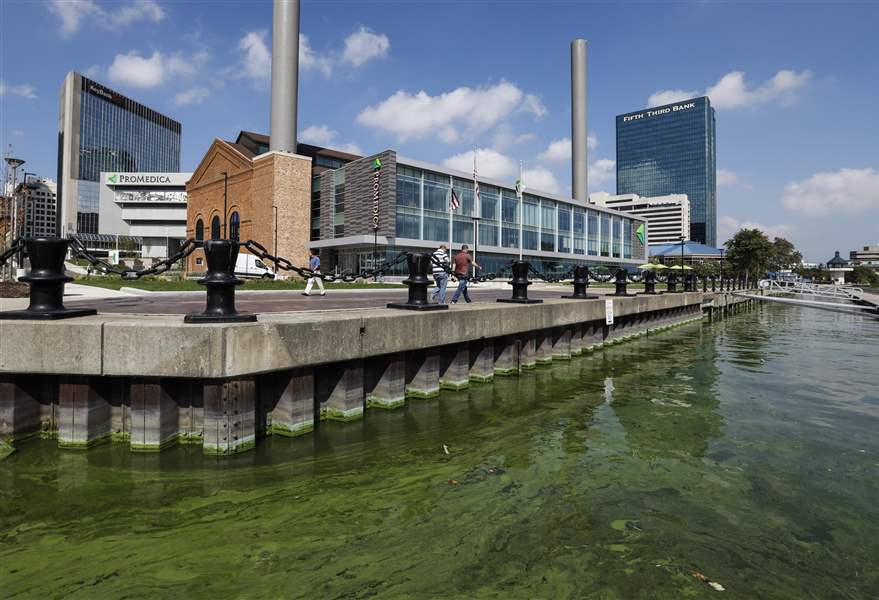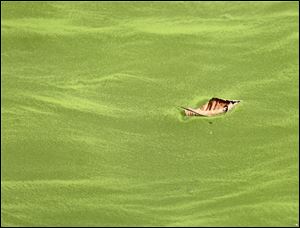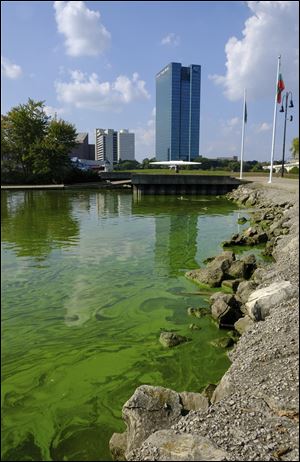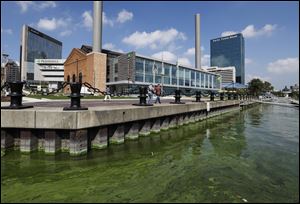
COMMENTARY
Algae in Maumee River yet another wakeup call for Toledo
10/12/2017
Algae in front of the new ProMedica Headquarters in downtown Toledo, Wednesday.
THE BLADE/ANDY MORRISON
Buy This Image
The green slime that oozed into the Maumee River last month was yet another wakeup call for a city that hardly needed one.

A fallen leaf sit on algae on the Maumee River at International Park in Toledo on September 22.
We have real problems with our lake and our river. And there isn’t an easy fix. We need to listen when scientists talk about what we can do to fix our water.
But we also need to listen when they tell us our water is safe to drink, as they’ve repeatedly done this summer.
A lot of people seemingly misplaced that trust last week when unsubstantiated rumors started circulating that we were about to be in for another water crisis like we saw in 2014.
I got text messages asking me what I knew. I heard from someone who heard from a friend who heard from a friend — who supposedly worked at the city’s water treatment plant — that the mayor was planning a major press conference to tell us our water was unsafe.
On that point, the rumor was half right.
Paula Hicks-Hudson did indeed hold a press conference. But it was to forcefully reassure Toledo, again, that the city’s water is safe to drink.
Even so, nervous Toledoans flocked to retailers and bought gallons and gallons of bottled water. Photos shared on social media showed empty pallets, picked clean because of nothing but fear and a rumor.

An algae bloom from Lake Erie appears in the boat basin at International Park in Toledo.
A spokesman for Kroger told me bottled water sales at its Toledo-area stores were up 80 percent last week over the prior year.
It’s understandable to be concerned. The algal bloom is disgusted. And we should be disgusted.
Not being able to use the water that comes bubbling out of your tap is crippling. It makes you doubt everything.
But, please, trust us that we’ll tell you if there’s a real problem.
And right now, there isn’t.
I called Tom Bridgeman, the University of Toledo’s Lake Erie Center algae researcher, and asked how much of the algae-produced toxin is currently in Lake Erie.
“As of now there’s almost no toxin near the Toledo water intake. Even if people don’t believe the city is capable of removing toxin, there’s no toxin to remove,” he said. “There’s no source of toxin right now.”
He understands the concern and the doubt people have, particularly in light of what happened in Flint.

Algae in front of the new ProMedica Headquarters in downtown Toledo, Wednesday.
But you don’t have to just believe the city of Toledo. Regular testing is also done by Bridgeman’s lab, and the The National Oceanic and Atmospheric Administration.
There’s also data being collected and reported in real-time, and much of that is available to the public.
And while Toledo was caught off guard in 2014, city officials say they’ve taken important steps to ensure that doesn’t happen again.
“We have better testing and sampling that’s consistent with everyone, and we have advanced warning for conditions on the lake,” said Janet Schroder, a spokesman within the city’s water department.
To better inform people, the city developed protocols for notifying the media, the public, and other water and public safety agencies of any changes in water quality. Part of that is the city’s water quality dashboard, which is updated daily.
Schroeder also said the city has bolstered its treatment capabilities since 2014 to handle potentially toxic lake water.
But again, there are no measurable level of microcystin toxins in Lake Erie where the city gets its raw water.
Contact Tyrel Linkhorn at tlinkhorn@theblade.com, 419-724-6134, or on Twitter @TyrelLinkhorn.